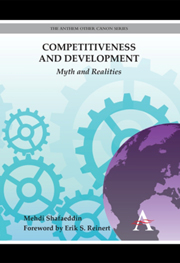Book contents
- Frontmatter
- Contents
- List of Tables, Figures and Boxes
- Foreword
- Preface
- Acknowledgements
- List of Abbreviations
- 1 Introduction: Framework of Analysis
- 2 Context and Conditions of International Competition
- 3 Alternative Theories of Competitiveness
- 4 Firm Strategy and New Industrial Organization
- 5 External Economies: Organization of Interfirm Relations
- 6 Reputation and Trust: A Firm's Relations with Stakeholders and Others
- 7 Innovation and Upgrading
- 8 Government Policies
- 9 The Experiences of China and Mexico
- 10 Summary and Concluding Remarks
- Appendices
- Bibliography
- Index
9 - The Experiences of China and Mexico
Published online by Cambridge University Press: 05 February 2013
- Frontmatter
- Contents
- List of Tables, Figures and Boxes
- Foreword
- Preface
- Acknowledgements
- List of Abbreviations
- 1 Introduction: Framework of Analysis
- 2 Context and Conditions of International Competition
- 3 Alternative Theories of Competitiveness
- 4 Firm Strategy and New Industrial Organization
- 5 External Economies: Organization of Interfirm Relations
- 6 Reputation and Trust: A Firm's Relations with Stakeholders and Others
- 7 Innovation and Upgrading
- 8 Government Policies
- 9 The Experiences of China and Mexico
- 10 Summary and Concluding Remarks
- Appendices
- Bibliography
- Index
Summary
The traditional role of the nation state is to support learning.
(Lundvall 1992)Introduction
China is on the road to competitiveness at a high level of development; Mexico is not. Why? To answer this question in this chapter we will briefly analyse the economic performance of the two countries before explaining the reason, which is related to the differences in policies they have implemented. We will show that China's economic performance in growth of GDP, MVA and competitiveness in the international market for manufactured goods has been unique during the last quarter-century or so. The country has managed not only to expand its exports of manufactured goods rapidly during the 1980s and 1990s before joining the WTO, but also to accelerate it after acceding to this organization. Upon acceding to the WTO, China relaxed protection of its manufacturing sector and subsidy of its exports. To do so, contrasting with Mexico, it has also managed to continue upgrading its industrial structure by enhancing the capabilities of its domestic firms while using FDI. The capabilities of domestic firms have been developed through active government policies despite China's commitments to the WTO for trade liberalization. While various government policies contributed to the competitiveness and upgrading of its industrial structure, technological and industrial policies played a major role. In the case of Mexico the country's performance in MVA has not been satisfactory despite its rapid growth of exports of manufactured goods until recent years. It has also managed little in upgrading its industrial structure.
- Type
- Chapter
- Information
- Competitiveness and DevelopmentMyth and Realities, pp. 207 - 258Publisher: Anthem PressPrint publication year: 2012



